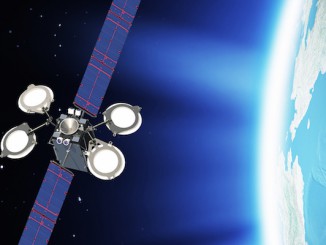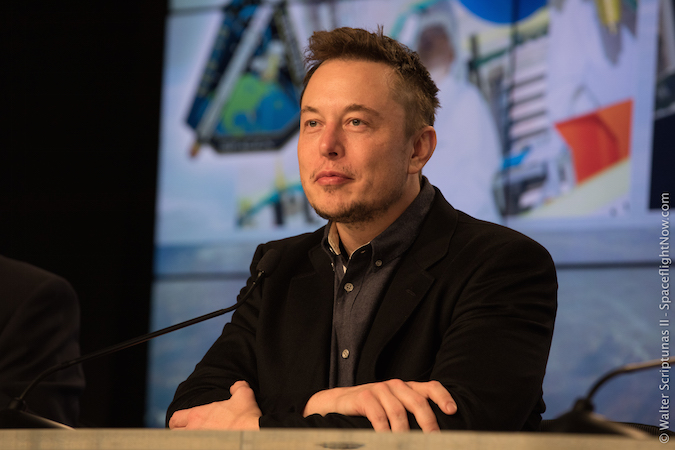
There’s a lot on SpaceX’s agenda this year if the company can maintain its pace, including refinements of the Falcon 9 rocket to hasten refurbishment between flights and the debut of the long-delayed Falcon Heavy launch vehicle with two side boosters recycled from previous missions, according to company founder Elon Musk.
The Falcon Heavy’s maiden flight is expected in late summer, Musk said Thursday after the launch of SpaceX’s first reused Falcon 9 rocket booster. It will be a “high-risk” mission, he said, and SpaceX plans to launch it on a pure demonstration flight.
Musk unveiled plans for the Falcon Heavy rocket in April 2011 in a press conference at the National Press Club in Washington. SpaceX said then that the triple-body rocket, powered by three rocket stages derived from the Falcon 9, would fly beginning in 2013.
SpaceX starting signing customers for Falcon Heavy missions in 2012, and the development delays forced at least two clients — Inmarsat and ViaSat — to switch their satellites to the rival Ariane 5 rocket, while retaining bookings for future launches.
“Falcon Heavy is one of those things that. at first, sounded easy,” Musk said Thursday. “We’ll just take two first stages and use them as strap-on boosters. Actually, no, this is crazy hard, and it required the redesign of the center core and a ton of different hardware.
“It was actually shockingly difficult to go from a single-core to a triple-core vehicle,” Musk said.
SpaceX says the Falcon Heavy is a secondary priority behind maintaining the launch tempo for the smaller Falcon 9. Officials blamed some of the Falcon Heavy delays on Falcon 9 failures in June 2015 and September 2016 that grounded the SpaceX rocket fleet several months each time.
Musk said SpaceX has around 20 more missions on its manifest this year, and only two will likely be with the Falcon Heavy, assuming it debuts by late summer.
Musk said major testing of the Falcon Heavy is complete, and engineers are now finishing fabrication of flight hardware.
“I think they finish in about two or three months,” he said.
The inaugural Falcon Heavy will lift off from launch pad 39A at NASA’s Kennedy Space Center in Florida, a facility first built for the Apollo program’s Saturn 5 moon rocket, then modified for space shuttle missions. SpaceX leased the pad from NASA in 2014, and rushed its upgrades to completion after a Falcon 9 rocket exploded on nearby pad 40 in September, leaving that launch complex with significant damage.
SpaceX will need several months to repair pad 40, then the company will relocate Falcon 9 launch operations there to fully outfit pad 39A for the Falcon Heavy. Managers also want to have pad 40 available in case a Falcon Heavy damages pad 39A, Musk said.
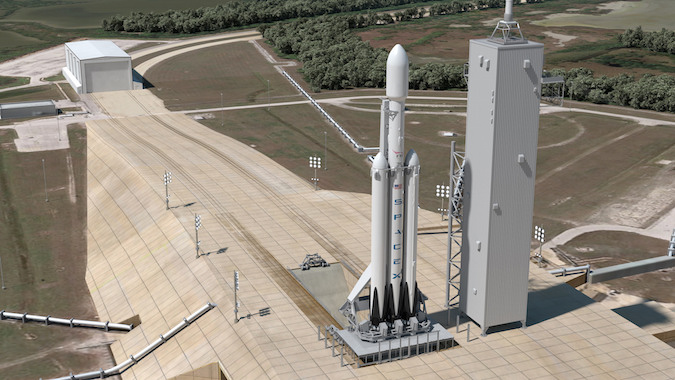
“Falcon Heavy, I really want to emphasize, that’s a high-risk flight — 27 engines are lighting simultaneously,” Musk said. “That’s a lot of engines.
“Technically, it should have been called the Falcon 27,” he joked. “Maybe that sounded too scary, so we called it the Falcon Heavy.”
SpaceX has not disclosed the orbital destination targeted on the first Falcon Heavy mission, but Musk said the company will likely fly “the silliest thing we can imagine” on the maiden flight.
SpaceX placed a wheel of cheese inside the Dragon spacecraft on its first orbital flight in an ode to the Monty Python comedy group.
“That will be exciting mission, one way or another,” Musk said. “Hopefully in a good direction.”
The two reused side boosters will detach from the central core a few minutes into the flight and return to Cape Canaveral for landing. The core booster will continue downrange and land on SpaceX’s ocean-going platform in the Atlantic.
“The two side boosters will come back and do sort of a synchronized aerial ballet and land,” Musk said. “Two of the side boosters will land back the Cape. That’ll be pretty exciting to see two come in simultaneously, and the center core will land downrange on the drone ship.”
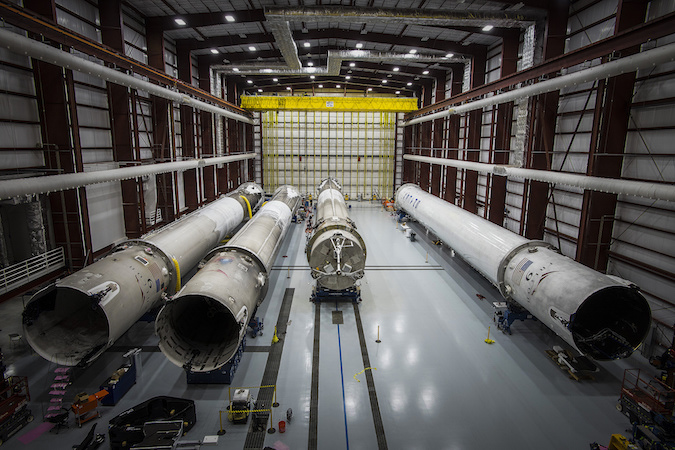
SpaceX may try to recover the second stage on the first Falcon Heavy flight in a maneuver never before attempted. The upper stage, which enters orbit at a velocity of more than five miles per second would need a beefier heat shield than the first stage, which comes down at lower speeds.
“Considering trying to bring upper stage back on Falcon Heavy demo flight for full reusability,” Musk tweeted. “Odds of success low, but maybe worth a shot.”
If the first Falcon Heavy flight goes well, the U.S. Air Force has booked the second launch to haul up multiple research satellites for the military, NASA and universities. The Space Test Program-2, or STP-2 flight will place the payloads in multiple orbits at different altitudes.
Thursday’s reflight of a previously-used Falcon 9 first stage booster went a long way toward SpaceX’s goal of recovering and rapidly relaunching rockets, an achievement Musk said could, theoretically, reduce launch costs by a factor of 100.
“The design intent is that the rocket can be reflown with zero hardware changes,” Musk said. “In other words, the only thing you change is you reload the propellant.”
SpaceX’s goal is to launch each Falcon 9 first stage 10 times with only inspections.
“Then, with moderate refurbishment that doesn’t have a significant effect on the cost, it can be reflown at least 100 times,” Musk said.
He said SpaceX’s engineers were “incredibly paranoid” preparing the previously-flown rocket for launch last week with the SES 10 communications satellite. The booster first flew in April 2016 carrying a Dragon supply ship toward the International Space Station, then landed on SpaceX’s offshore platform.
The rocket repeated that feat Thursday, again returning to Earth on SpaceX’s drone ship.
“The core airframe remained the same,” Musk said. “The engines remained the same, but any auxiliary components that we thought might be slightly questionable, we changed out.”
SpaceX plans up to six more reflights of Falcon 9 first stage boosters this year, including the two side boosters on the first Falcon Heavy. Officials have not identified customers for the other reuse launches, but SES chief technology officer Martin Halliwell told reporters that the SES 14 and SES 16 communications satellites scheduled to launch on Falcon 9 rockets in the fall are candidates to ride on a previously-flown launch vehicle.
The company recently leased a disused former Spacehab processing facility near the southern gate of Cape Canaveral Air Force Station to refurbish rocket hardware. SpaceX has retrieved eight first stage boosters to date — including landing one vehicle twice — but at least three of those first stages are not intended to fly again.
The first booster that landed at Cape Canaveral in December 2015 is on display outside SpaceX’s headquarters building in Hawthorne, California, and the first stage that launched last week with SES 10 will be put on public display somewhere at the Florida spaceport. Engineers ran through a series of extensive ground testing with a rocket that lifted off with a Japanese communications satellite last year, leaving it unsuitable for a second launch.
Another upgrade to the Falcon 9 family is due later this year to ease the work needed between flights of the same first stage booster, raise the power of the rocket’s Merlin engines, and test out safety features for future launches with astronauts.
The so-called Block 5 configuration of the Falcon 9 will fly at least seven times with a “frozen” design before NASA puts astronauts on the rocket, according to space agency officials.
SpaceX is one of two companies — along with Boeing — working on commercial spaceships to ferry crews to and from the space station. The Crew Dragon capsule will launch on Falcon 9 rockets from pad 39A, and SpaceX has finished construction of a new access arm for astronauts to board the spacecraft before liftoff.
The access arm will be installed at pad 39A some time later this year during a lull in launch operations.
A test flight of the Crew Dragon spaceship without astronauts aboard is penciled in on SpaceX’s manifest for November, followed by a demonstration with two crew members no sooner than May 2018.
NASA considers those target launch dates optimistic, and they assume everything goes according to plan, said Kathy Lueders, manager of NASA’s commercial crew program, in a presentation last week to the NASA Advisory Council’s Human Exploration and Operations Committee.
“The most important part of Block 5 will be operating the engines at their full thrust capability, which is about 7 or 8 percent — almost 10 percent — more than what they currently run at,” Musk said. “And a number of other important (things) to have reusability go smoothly as well, like the forged titanium grid fins. It’ll bring in a bunch of other factors.”
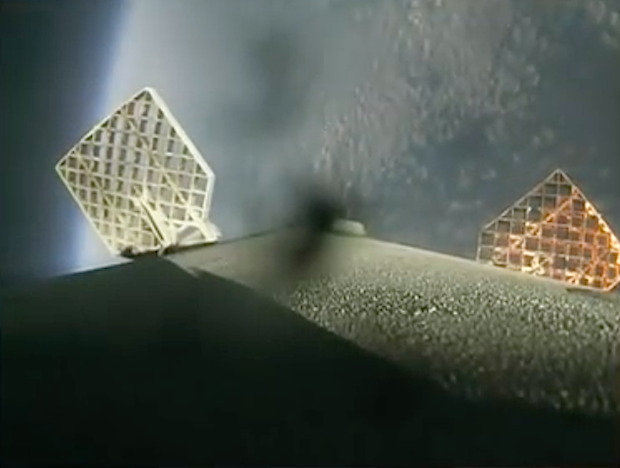
The new grid fins will replace the first stage’s current aluminum winglets, four of which help stabilize and steer the rocket during descent. SpaceX added the grid fins to the first stage after initial experiments with ocean landings, incorporating the deployable fins to improve steering.
On a typical launch, the first stage jettisons from the upper segment of the Falcon 9 around two-and-a-half minutes after liftoff, then activates cold gas nitrogen thrusters to to flip around to fly tail first. Soaring above 60 miles (100 kilometers) in altitude, the internationally recognized boundary of space, a subset of the booster’s nine Merlin engines then reignite multiple times to slow down for a vertical landing.
“Some of the technical elements that are the most tricky, I think, for reuse are the base heat shield of the rocket (and) the grid fins,” Musk said. “If you saw the webcast (of SES 10’s launch), you may have noticed the grid fins were lighting on fire.”
The aluminum grid fins currently flying on the Falcon 9 are covered in heat shield material.
“But it gets so hot that it lights on fire a little bit, which is not great for reuse,” Musk said. “The new grid fins should be capable of taking a scorching and being fine.”
The upgraded rocket will have more control authority on descent, Musk added.
“It will actually improve the payload to orbit by being able to fly at a higher angle of attack, and use the aerodynamic elements to effectively glide,” Musk said. “It actually does have a lift-over-drag (ratio) of roughly one if flown at the right angle of attack, but you need control authority, particularly pitch control authority.”
Engineers want to add a thermal barrier coating to replace the paint currently used on the first stage, which can melt and bubble from the extreme heating of re-entry.
The heat shield at the base of the rocket protects the engines and the plumbing of the booster’s propulsion system. It currently has to be replaced between each launch of the same rocket.
“I think we’ve got the base heat shield thing addressed,” Musk said. “We’ve got a good plan for the grid fins, and there are a bunch of little things that need to be ironed out.”
But Musk said he is optimistic SpaceX can achieve his goal of landing and reflying a first stage booster within 24 hours as soon as next year.
“It does seem as though we may do maybe half a dozen more flights of a reflown booster this year, and then next year probably double that,” Musk said. “Then I would suspect that, for the Falcon architecture over time, probably three-quarters of our missions, or more, are with a reflown booster.”
Engineers also are experimenting with recovering the Falcon 9 payload fairing, a composite structure that covers satellites during the first few minutes of launch, then splits open in two halves to fall into the sea.
Musk confirmed one half of the fairing from the SES 10 launch Thursday landed intact, using tiny thrusters and a steerable parachute to soften its splashdown in the Atlantic Ocean.
The Block 5 upgrade — Musk said he prefers to call it Version 2.5 — will include around 100 changes to the vehicle, according to Gwynne Shotwell, SpaceX’s president and chief operating officer.
Shotwell said in February that the changes include a fix to a turbine wheel cracking issue in the Falcon 9’s Merlin engines publicly disclosed in a government watchdog report.
Musk’s long-term objective for SpaceX is to dispatch huge transport ships to Mars, eventually carrying hundreds or thousands of people to settle on the red planet.
Rocket reusability “is a critical part of the Mars plan, if you consider the goal … is not to be a single mission, but one where we establish a self-sustaining city on Mars,” Musk said.
Email the author.
Follow Stephen Clark on Twitter: @StephenClark1.
Comments will be monitored for language.


